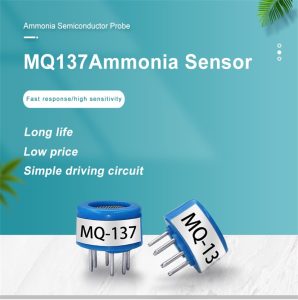Clean and fresh air is essential for our well-being, especially when we spend a significant amount of time indoors. However, with the rise of pollution and various contaminants, ensuring good indoor air quality has become more challenging. This is where gas sensors play a crucial role in monitoring and improving indoor air quality. In this article, we will explore the importance of gas sensors, their applications, and how they are shaping the future of indoor air quality.
Understanding Gas Sensors: Gas sensors are devices that detect and measure the presence of gases in the surrounding environment. They work by converting the chemical reactions caused by different gases into measurable electrical signals. These sensors can detect a wide range of gases, including carbon dioxide (CO2), carbon monoxide (CO), volatile organic compounds (VOCs), and various air pollutants.
Importance of Indoor Air Quality: Indoor air quality has a direct impact on our health, comfort, and productivity. Poor indoor air quality can lead to various health issues like allergies, respiratory problems, and even long-term health effects. It is particularly crucial in buildings where people spend a significant amount of time, such as homes, offices, schools, and hospitals. Monitoring and maintaining good indoor air quality is essential for creating a healthy and conducive indoor environment.
Applications of Gas Sensors in Indoor Air Quality Management: Gas sensors are extensively used in various applications related to indoor air quality management. Let's explore some of the key areas where gas sensors are making a significant difference:
- Ventilation Systems: Gas sensors play a vital role in monitoring the air quality of indoor spaces and ensuring effective ventilation. They can detect the levels of carbon dioxide, which is an indicator of the occupancy and ventilation requirements of a space. By continuously monitoring CO2 levels, gas sensors can provide feedback to ventilation systems to adjust airflow rates and ensure a constant supply of fresh air.
- Detecting Harmful Gases: Gas sensors are used to detect harmful gases like carbon monoxide (CO). CO is a colorless and odorless gas produced by the incomplete combustion of fuels. It is highly toxic and can be fatal in high concentrations. Gas sensors in homes and workplaces can trigger alarms when CO levels exceed safe limits, providing early warnings and preventing potential hazards.
- Volatile Organic Compounds (VOCs) Monitoring: Volatile Organic Compounds (VOCs) are emitted by various sources like cleaning products, paints, furniture, and building materials. Prolonged exposure to VOCs can lead to respiratory issues, allergies, and other health problems. Gas sensors can detect and measure VOC levels, enabling proactive measures to reduce emissions and maintain healthier indoor environments.
- Air Purification Systems: Gas sensors are integrated into air purification systems to monitor pollutant levels and trigger purification processes accordingly. They can detect pollutants like particulate matter, pollen, mold spores, and harmful gases. By continuously monitoring the air quality and adjusting purification processes, gas sensors ensure cleaner and fresher indoor air.
- Smart Homes and IoT Integration: Gas sensors are increasingly being integrated into smart home systems, allowing homeowners to monitor and control indoor air quality from anywhere. These sensors can be connected to IoT platforms, enabling real-time data tracking, analysis, and alerts. With the help of smartphones or other devices, users can access air quality information, receive notifications, and remotely control ventilation and air purification systems.
The Future of Indoor Air Quality with Gas Sensors: As technology advances, gas sensors are becoming more sensitive, reliable, and affordable. This opens up new possibilities for enhancing indoor air quality management in the future. Here are some developments that we can expect:
- Improved Sensor Technologies: Gas sensor technologies will continue to evolve, offering higher accuracy, faster response times, and the ability to detect a wider range of gases. This will enable more precise monitoring and help identify even trace amounts of pollutants, ensuring better air quality control.
- Integration with Artificial Intelligence (AI): Gas sensors integrated with AI algorithms can analyze large volumes of data in real-time and provide valuable insights into air quality patterns. These systems can learn from past data, predict trends, and optimize ventilation and purification processes to maintain optimal indoor air quality automatically.
- Personalized Air Quality Monitoring: Advancements in wearable sensor technologies will allow individuals to monitor their personal exposure to pollutants in real-time. These portable gas sensors can provide personalized air quality data, empowering individuals to make informed decisions about their surroundings and lifestyle choices.
- Collaboration with Other Technologies: Gas sensors have the potential to collaborate with other smart technologies such as occupancy sensors, temperature sensors, and humidity sensors. Integration of these devices can provide a comprehensive understanding of the indoor environment, enabling more efficient and effective air quality management systems.

Conclusion: Gas sensors are revolutionizing the way we monitor and improve indoor air quality. They play a vital role in ensuring the health, comfort, and well-being of individuals in indoor spaces. With advancements in technology, gas sensors are becoming more advanced, accessible, and integral to the future of indoor air quality management. By leveraging the power of gas sensors and other emerging technologies, we can create healthier, safer, and more sustainable indoor environments for everyone. So, let's take a breath of fresh air and embrace the promising future of indoor air quality with gas sensors.
 : +86 155 8830 2704
: +86 155 8830 2704 : jxdziot@gmail.com
: jxdziot@gmail.com
